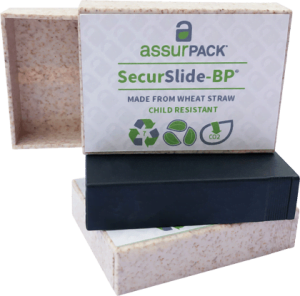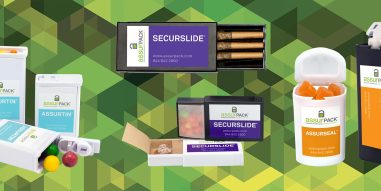The Ultimate Guide to Sustainable Cannabis Packaging
June 4, 2020
Cannapreneurs know that being green is more important than ever. Not only does our ailing Earth demand eco-friendly packaging but cannabis consumers do too. Moreover, in today’s oversaturated marketplace, sustainable cannabis packaging can boost your brand and make you stand out.
And a commitment to sustainability attracts a very important market segment: Millennials. According to the market research firm Nielsen Global, an astounding 73% of Millenials are willing to pay more for sustainable products. Cannabis-specific market research is limited, but it’s safe to say that most cannabis consumers value environmentally friendly brands.
Read on to discover the benefits of sustainable packaging for cannabis and how AssurPack is using bioplastics to decrease carbon emissions — without compromising your products’ quality.
Your Eco-Friendly Cannabis Packaging… Probably Isn’t
Truth be told, sustainability is complicated. Anyone can say a product is sustainable, or eco-friendly, or “green.” If you look around at the shelves of your supermarket, you’ll find plenty of greenwashing. “Greenwashing” is when a company deceptively implies that their products are sustainable when they aren’t. Just because a product has Earth-loving advertising or a picture of a beautiful farm doesn’t mean it’s different from the others. What matters are third-party certifications and hard proof.
The same is true for cannabis packaging solutions. Is the folding carton paperboard for your product really made from recycled paper? And if it was, how would you know? Moreover, what are the trade-offs that took place to get that benefit? For instance, a low-carbon production technique might release harmful chemicals into the water table. Or an eco-friendly product might actually incur more emissions in the shipping process because of its manufacturing facility’s location.
What is Sustainable Packaging?
For those who care about the environment, the terminology of sustainability proves challenging too. First, there’s the word “green,” which means very little. It vaguely implies an intention to environmental stewardship. Then, there are more specific terms like “recycling” and “recycled.”
When we say that a product is recycled, we mean it’s been manufactured with reclaimed, non-virgin materials that have been used before in other products. Often, recycled materials are a percentage of the total product; splicing in virgin material improves the performance of the reclaimed materials, which may not be as durable. If a product is “recyclable,” that indicates that it can be reprocessed into specification-grade stock — at least in theory. In many areas, the appropriate recycling facilities don’t exist, which further complicates what “recycleable” means in the real world.
In the cannabis packaging industry, the terms “biodegradable” and “compostable” get thrown around a lot. Marketing departments use them to express their products’ sustainability but the real story is more complicated. When a substance is biodegradable, it degrades from the natural action of microorganisms in the soil, and breaks down to a microscopic level over a relatively short period of time. Compostable substances, on the other hand, break down into usage soil that’s nutritious to plants.
There is no overarching standard or certification for biodegradability. And biodegradability is a tricky concept in and of itself. You could argue that all materials — including conventional plastics — are biodegradable and will eventually break down into soil. But for many plastic products, this can take hundreds of years. European Standards defines packaging as compostable (BS EN 13432:2000) when it can be recovered through composting and biodegradation. But again, the term has caveats: composting must be performed in commercial facilities, not a backyard garden. So when you see a marijuana product packaging labeled as “biodegradable,” it’s usually a subjective claim.
How to Use Sustainability to Increase Sales
With so many factors complicating being “green,” how can you convey your environmental conscience to consumers in direct terms? After all, most consumers don’t have the time for extensive research about your production processes and packaging. That’s what makes greenwashing so effective; few people will take the time to really examine a manufacturer’s claims.
The first thing consumers see when they experience your product is your packaging, so it’s an important cornerstone in your sustainability messaging. Select sustainable materials when you can, and make sure to communicate them as such on your label.
That label — and the rest of your advertising — should convey your “greenness” in a manner not unlike the greenwashers — except you have the credentials to back it up. Display your certifications wherever possible. If you can, make note of any environmental certifications or recycled materials that are included in your packaging, such as FSC Certified carton board or bioplastics.
Most importantly, build sustainability into your brand story. Show a true commitment to the environment and document it with your social media, website, and advertisements. Giving back to environmental causes through donations of time and, if possible, money shows that you care. It’s a chance to be transparent, demonstrate your integrity, and back up your intentions with a story that extends beyond certifications.
Some packaging that’s made from sustainably sourced materials can compromise your product quality, and the bottomline is that a packaging solution needs to protect your product. The fidelity of recycled materials might not match conventional materials so it’s important to strike a balance. If it can’t, your brand suffers (along with your customers). That’s not sustainable — in any sense of the word. You need packaging that’s both environmentally friendly and efficacious. And that’s our philosophy at AssurPack.
Bioplastic Cannabis Packaging and The AssurPack Pledge
Whenever possible, we use recycled and sustainably sourced materials. But sustainability is complicated. We know that eco-friendly materials have limitations, and that your product quality is critically important. That’s why we’re pushing for greater sustainable technologies while also “designing around the problem.”
Minimalist packaging stops waste before it starts, so we favor sleek, efficient designs regardless of whether or not recycled materials can be included. Our AssurClam, for instance, is compact and utilizes recycled materials (and also maintains CPSC child resistant standards).
In a perfect world, your packaging would never end up in a landfill or even need to be recycled — it’d be reused again and again. The AssurPack MarBox and AssurPack SecurSlide Matchbox increase the chance that your customers save your packaging for other purposes or use it as an on-the-go box. Hopefully, your branded label stays with them, too, as a repeated reminder of your products.
Introducing the SecurSlide® BP Matchbox

Our package engineers have developed what we believe is a perfect balance between sustainability, reusability, and uncompromising product protection: the SecurSlide BP Matchbox. The latest iteration of our customer-favorite SecurSlide features wheat straw resin in combination with conventional polystyrene to cut carbon emissions in half.
Wheat straw is a 100% renewable resource. It’s a versatile resin derived from the otherwise wasted biomass of food production and, when combined with traditional polystyrene, provides unsurpassed durability and production protection. After its use, the wheat resin blend can enter into the recycling stream as #7 plastic.
The SecurSlide BP is available in two colors: black and natural. Both have a distinctive speckled texture that indicates their earth-friendly materials, and the natural color is a great choice for emphasizing your commitment to sustainability. The SecurSlide is perfect for edibles, concentrates, vape cartridges, and pre-roll packaging. Our six available sizes can be configured with custom inserts such as silicone liners for freshness protection.
Want to experience the BP SecurSlide first-hand? Reach out to an AssurPack representative today. We’ll send you a sample of our bioplastic SecurSlide so you can see for yourself how the BP SecurSlide works for your product.




